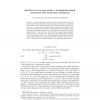VRIPHYS
2010
14 years 6 days ago
2010
We present a novel approach to fluid simulation, allowing us to take into account the surface energy in a precise manner. This new approach combines a novel, topology-adaptive app...
SYMMETRY
2010
14 years 7 days ago
2010
: The theory of elasticity is used to predict the response of a material body subject to applied forces. In the linear theory, where the displacement is small, the stress tensor wh...
SIAMREV
2010
14 years 8 days ago
2010
We examine condition numbers, preconditioners, and iterative methods for finite element discretizations of coercive PDEs in the context of the fundamental solvability result, the L...
SIAMNUM
2010
14 years 8 days ago
2010
Infimizing sequences in nonconvex variational problems typically exhibit enforced finer and finer oscillations called microstructures such that the infimal energy is not attained. ...
SIAMNUM
2010
14 years 8 days ago
2010
We develop a mixed finite element method for elliptic problems on hexahedral grids that reduces to cell-centered finite differences. The paper is an extension of our earlier paper...
SIAMNUM
2010
14 years 8 days ago
2010
Abstract. In [9], we introduced and analyzed a recovery-based a posteriori error estimator for conforming linear finite element approximation to interface problems. It was shown th...
SIAMNUM
2010
14 years 8 days ago
2010
In this paper we develop an a posteriori error analysis of a new conforming mixed finite element method for the coupling of fluid flow with porous media flow. The flows are govern...
SIAMNUM
2010
14 years 8 days ago
2010
In [Z. Cai, C. Tong, P. S. Vassilevski, and C. Wang, Numer. Methods Partial Differential Equations, to appear], the authors developed and analyzed a mixed finite element method for...
PROCEDIA
2010
14 years 8 days ago
2010
We argue that producing maintainable high-performance implementations of finite element methods for multiple targets requires that they are written using a high-level domain-speci...
MOC
2010
14 years 9 days ago
2010
Abstract. We prove pointwise a posteriori error estimates for semi- and fullydiscrete finite element methods for approximating the solution u to a parabolic model problem. Our esti...




